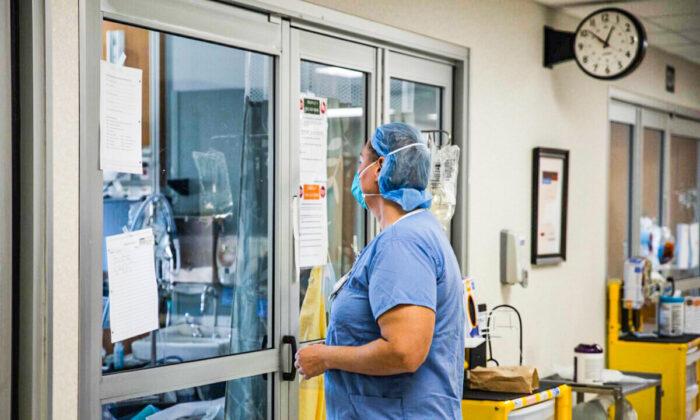Many hospitals in the United States raked in more money during the first two years of the COVID-19 pandemic, partially due to an infusion of funds from the federal government, according to a new study.
About three-quarters of the hospitals analyzed by researchers had a positive net operating income in 2020 and 2021. That was up about 12 percent from before the pandemic.
The researchers also found that 68 percent of the hospitals recorded an improvement in the net operating income from before the pandemic, with a median change of $4.4 million.
The moneymaking grew so much that some hospitals hit peak operating margins or historic profitability.
While COVID-19 relief funding was largely allocated well to hospitals, “there were some hospitals who curiously did far better during the pandemic—and much of this was due to COVID-19 relief funding,” Risha Gidwani with the RAND Corporation, one of the researchers, told The Epoch Times via email. “The size of the COVID relief was too large for many hospitals.”
Net operating income was defined as operating revenue minus operating expenses, or a hospital’s profit before taxes. During the pandemic, income included COVID-19 relief funding, such as payments from the Coronavirus Aid, Relief, and Economic Security Act. The bill, approved in bipartisan votes and signed by then-President Donald Trump, increased Medicare payments for the treatment of patients with positive COVID-19 tests.
Operating margin was defined as net operating income divided by operating revenues. The margin helps compare different-sized hospitals because a hospital that earns $4 million on $100 million in revenue would have the same 4 percent margin as a hospital with an income of $32 million on $800 million in revenue.
Researchers took data from the RAND Corporation and the American Community Survey and included every short-term acute care and critical access hospital that had financial data from 2017 through 2021. The number of hospitals analyzed was 4,423.
Some Losses
Before the pandemic, 36 percent of the hospitals had a negative operating margin. During the pandemic, that dropped to 24 percent.The percentages were similar for net operating income. After a decline of 10 percent from before the pandemic, just 25 percent of hospitals were operating with a negative income.
Most of the hospitals with a negative income in 2020 and 2021 had a negative income going into the pandemic and were unable to turn things around, even if they received government relief funding.
A small number of hospitals, or 284, fared substantially worse in the initial pandemic years, suffering negative net operating income after operating positively before the pandemic started. But nearly triple that number fared substantially better, moving from a negative to a positive income.
Relief Funding
The funding from the federal government played an important role in increasing the profitability of hospitals or helping hospitals avoid pandemic distress.Three out of ten hospitals avoided pandemic distress because of the funding, the researchers found.
More than three-quarters of the hospitals, though, that would not have experienced distress without funds still received funding, with the researchers saying that raises questions “about the appropriateness of relief funding for these hospitals and how relief funding may be better targeted in the event of a future pandemic.”
“Given that half of all hospitals had 2020/2021 operating margins that exceeded pre–COVID-19 all-time high values for operating margins suggested that COVID-19 relief funds allowed some hospitals to achieve top financial performance, rather than address financial solvency,” they said.
Aaron Wesolowski, a vice president at the American Hospital Association, which lobbied for federal funding for hospitals, said the research had problems, including that “each hospital and health system came into the pandemic with their own unique financial situation.”
“Incomplete analyses like this are not reflective of the many immense struggles and challenges the hospital field has faced and continues to face, including a workforce shortage crisis, along with skyrocketing input costs for supplies, equipment, drugs and labor, and persistent inflation,” Mr. Wesolowski said. “It is in everyone’s interest to keep hospitals strong and our patients healthy.”
Previous Research
Previous studies, analyzing smaller chunks of time, have examined whether hospitals’ margins were similar during the pandemic when compared to prior periods of time.“Government assistance played an important role in the increase in other operating revenue and helped to contain what could have been a much more dire situation for hospitals,” they said.
Hospitals affiliated with academia received more money, as did hospitals with higher numbers of COVID-19 cases, the researchers found. They recommended that policymakers ensure various hospitals receive adequate funding, especially those in rural areas and focused on critical care.
In the new study, researchers found that critical access hospitals received on average about $3 million less when compared to short-term acute care hospitals.





